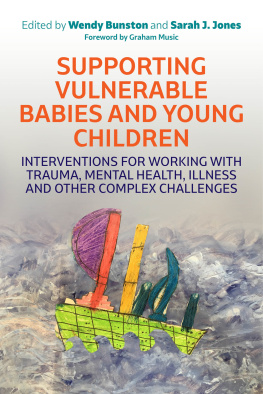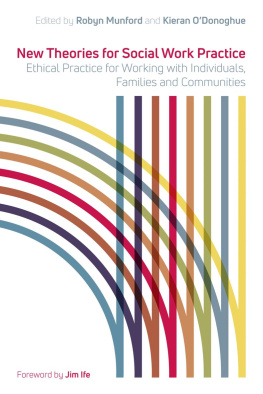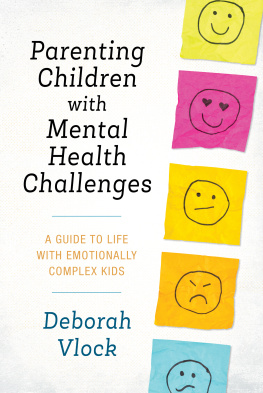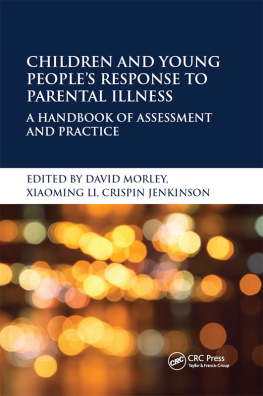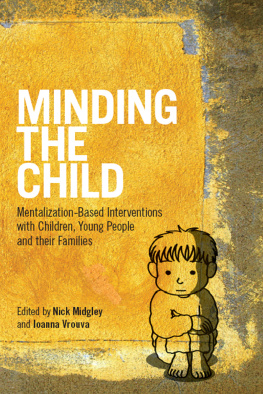
Supporting
Vulnerable Babies
and Young Children
Interventions for Working with Trauma,
Mental Health, Illness and Other
Complex Challenges
Edited by
Wendy Bunston and Sarah J. Jones
Foreword by Graham Music

Jessica Kingsley Publishers
London and Philadelphia
Contents
Foreword
BY GRAHAM MUSIC
This wonderfully rich book provides a truly international perspective on the importance of infancy as a vital developmental period, highlighting the challenges we face in ensuring that knowledge from clinical work and research is catapulted up the agenda of policy makers and service development.
While such issues been well described in many books, academic papers and policy documents (Gerhardt, 2014) it is worth reiterating why the kind of work championed by this book is so vitally important.
The human infant is extraordinarily adaptive, psychologically, physiologically, emotionally, culturally and neurobiologially. Prenatally the foetus is already adapting to its environment (Music, 2013), and the human brain is extraordinarily adept at responding to whatever environment it finds itself in. Indeed we are beginning to learn how intergenerational epigenetic effects, the sins of the fathers, are transmitted intergenerationally and leave their mark (Bouvette-Turcot, Meaney and ODonnell, 2018).
In our early years our neurochemical systems are becoming programmed, our brain architecture being wired, our autonomic nervous system is developing specific patterns, our inner worlds are being framed, even our genes are coming to be expressed in specific ways via epigenetic processes, all so we learn to survive and if possible, thrive, in the family, culture, social group and emotional environment that fate has landed us in.
Babies within days even cry differently, if they born into a French or German family, for example. Yet how much more profoundly important are the early adaptations to, for example, serious trauma, or neglect, or loving parenting, each giving rise to profoundly different behavioural and emotional responses which become later templates for being-with-others-in-the world.
This book brings alive so many of these fundamental processes. We read about powerful interventions, rooted in psychoanalytic, attachment and other depth psychology approaches, but each delivered with a sensitivity to the importance of engaging real, distressed parents and infants at a level they can relate to. The infant is always placed centre stage, as a real person with feelings, thoughts, and a huge range of potentials. Yet the chapters all keep very much in mind the context around the child, the families, cultural issues, political agendas, providing a masterly synthesis of macro and micro issues.
Several key issues recur throughout the chapters that are dear to my heart and I hope bear reiterating. As already hinted at, an understanding of cultural issues and diversity runs through many chapters, and such cross-cultural awareness challenges any idea that there is one way to raise a child, to live a life, avoiding the dangers of an overly normative approach to infancy and parenting which can become another form of cultural imperialism.
Trauma is central to many chapters and trauma shows its face and takes its toil in a variety of ways and at many levels. We are increasingly aware of the devastating effects of violence, abuse and neglect on the developing brain (Teicher et al ., 2016). In addition, we absolutely know how the state of mind of the parent affects the developing mental and emotional state of the infant. Beebes work on disorganised attachment (Beebe et al ., 2012) should leave us in no doubt how babies adapt to overwhelming experiences. At just 4 months babies whose mothers display frightening behaviours learn to adapt, such as by starting to whimper in the face of threat, but then shifting the whimper to placatory smiles so as not to alienate mothers who cannot bear negative affect. Such reactions and states then become engrained personality traits (Perry et al ., 1995) that are hard to shift without timely skilled help. Indeed, since Fraibergs pioneering early week, we have known how infants adopt profound defences in the face of trauma and abuse (Fraiberg, 1982).
Such understanding from micro-analysis has shown for example, how maltreatment in a parent affects their very capacity to make sense of and be attuned to their infants states of mind (Thompson-Booth et al ., 2018), something that child psychotherapy, as well as research which looks at the inner world and symbolic communications of children have long asserted (Hodges et al ., 2003). This is of course another argument for early interventions with parents and their infants.
Many chapters in the book are influenced by both the traditions of infant observation (Miller, 1989), and of parent-infant psychotherapy (Hopkins, 1992; Baradon et al ., 2016). The thinking is imbued with the psychoanalytic capacity to bear and face the unthinkable nature of much that the authors have helped their clients bear, heling their clients to face issues as diverse as natural disasters such as Tsunamis, children suffering horrendous cancers, the fallout from the refugee crisis and asylum seeking, intergenerational ethnic discrimination, family violence, alcohol and other addictions, and so much more. We read accounts in which these issues are faced head-on, and yet in which hope and resilience shine though.
One theme which I feel needs underlining and shouting loudly about is one which often leaves people cold, uninterested and too quiet, and hence is not taken seriously enough. This is the issue of serious child neglect, which is too often itself neglected (Music, 2018b). Emotional neglect is different to the kinds of physical neglect that social workers often act on and is hard to recognise and prove. However its consequences are often more devastating than overt trauma, on brains, psyches, relationship capacities (Nelson, Zeanah and Fox, 2019). The classic examples were seen in some of the infamous depriving orphanages (Rutter et al ., 2007), but in fact this is far more widespread yet goes unrecognised as such neglected children rarely elicit worry and concern, having shut-down their evolved inherited expectation of and demand for interpersonal contact (Music, 2018a). The babies who do not cry and seem just fine can become children unnoticed at backs of classrooms and adults who live lives deadened and unfeeling. They often have far worse prognoses, but their plight goes silently unnoticed.
The thinking in this book is about extremely serious matters. As the science backs up what therapists have long known, we can no longer deny how adverse experiences are not about soft touchy-feely matters, but have profound effects on later psychological and physical health outcomes, including deadly diseases and early death (Hughes et al ., 2017). We know how trauma and other early adverse experiences affects the brain (McCrory, Gerin and Viding, 2017), the nervous system (Porges, 2011), and a range of biomarkers from telomeres to DNA expression (Ridout, Khan and Ridout, 2018) We ignore this at our peril.
This book is full of deep thinking and good practice about such cases, describing a wide range of work with infants in a variety of contexts, infants experiencing an array of distressing experiences which are a challenge both to those in contact with them, and of course to the extraordinarily sensitive and adaptive infants themselves. The following chapters will offer something invaluable to anyone working with infants, from experienced practitioners to the novice to the policy-maker to the researcher, and many more. The reader is invited to partake of a feast, a veritable smorgasbord of practical wisdom, insight, research findings, interventions, all with the infant and their inner world and emotional needs at its centre. The work described might be a challenge at times to digest, but with our hand held by these skilled practitioners and writers, we soon realise that, in the words of Bion (1962), digesting and metabolizing such experiences, understanding them not just intellectually but emotionally, will be health-enhancing not only for the reader, but of course also for the infants and families we work with, and indeed for the subsequent generations of those we offer help to.
Next page
